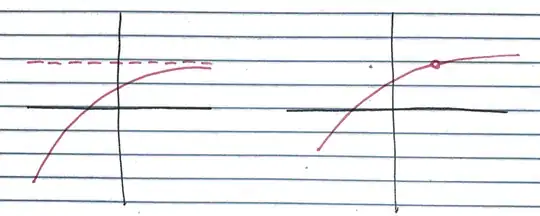This is an answer on the question from the khanacademy.org
Full credit for this answer goes to the user "Tronax" from khanacademy.org:
I will try to show the difference between the two types of what we previously called "undefined".
Let's start with the "removable discontinuity", which actually says, that the graph at the point of x could be absolutely any y! And there is no way to find it. It could be 0, -7, 65, 23/7, 3982.3 etc. Math guys agreed between themselves, that if they can't understand it better and find its value - it does not exist. So now we just draw an empty circle on the curve of our graphs in spots that are known to have a removable discontinuity.
This happens if the function is of a form that includes the same non constant factor in both numerator and denominator. For example y = (x+1)(x+2) / (x+1). Notice (x+1) factor is both on the numerator and on the denominator.
For x=-1, (x+1) equals zero, so we say that at x=-1 function has a removable discontinuity.
But... why?
Because when you input x=-1 and try to solve for y:
y = (-1+1)(-1+2) / (-1+1)
y = 0*(-1)/0
y = 0/0
or (this is one of interpretations):
0y = 0
You could substitute any number into y, this expression will fit them all, since anything multiplied by 0 equals 0.
This is removable discontinuity. The graph around the point of it, looks just like it would, if there was no removable discontinuity.
The second type is the "vertical asymptote". It occurs when for some x, the denominator (and only denominator) equals zero. It's somewhat easier to understand. Let's think about what happens when we see 8/4. This says: how many times, can we fit the denominator 4 into 8? It takes 2 times. For 8/2 it takes 4 times; for 8/1 - 8 times; 8/0.5 - 16 times; 8/0.25 - 32 times. The lower and closer to zero our denominator gets, the more times we can fit it into the same 8. When it becomes really really small, it can take millions of times! When it gets such a small number that we can barely distinguish it from zero, it seems like it would take almost infinite times of that number to fit our 8! That's why when denominator approaches 0, we say that the result approaches infinity.
When x approaches 0, y=8/x approaches infinity and y=-8/x approaches negative infinity.
Don't be confused, when x actually equals zero, y=8/x is undefined! In this case, you could say that even infinity is not enough :)
When saying "approaches zero", we only mean that it gets very very very close to zero, but not zero.
"Vertical asymptote at x = k" only refers to what happens before and after k on the graph. x = k itself is undefined.
The graph before and after vertical asymptote quickly gets almost parallel to the y-axis.
Hope this is helpful.
Source: https://www.khanacademy.org/math/algebra2/rational-expressions-equations-and-functions/discontinuities-of-rational-functions/v/discontinuities-of-rational-functions
